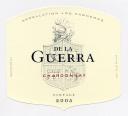Straw gold in color, this wine had a toasty, creamy aroma on the nose, with a teensy hint of ripe apple. It was served at about 40 degrees F (I asked about the temp of their fridge), so I let it warm up a little before I continued to taste, because I wasn’t smelling much more than the oak.
Upon warming, the wine presented a slightly honeyed creaminess and some sharp pear aroma. When I tasted it, I noticed some oak tannins and a good dose of mineral on the mid-palate, which almost felt astringent. Maybe the astringency came from the oak tannins; I’ve never noticed mineral coming across as astringent before, but that’s how it seemed at the time. Fruit on the palate was a rather lemony-green apple, but super-integrated.
I was really surprised by this wine, because the winemaker is big-time Burgundian Stephane Vivier, and I confess I was looking forward to a less opulent, more oak-free Chardonnay. This is a decently well-made wine, but not a style I enjoy much. (Looking at the tasting notes from the winery’s website, they’re all about the citrusy finish, which my poor tastebuds did not detect. Maybe the wine was damaged in shipping? I didn’t taste anything off. Ah, well.)
If you must pair this with food, go with a pasta alfredo or something involving brie. In my mind, though, this is a Drink-It-On-Its-Own wine. If I had purchased it for $35, I would be disappointed.
About the winery: HdV is a joint venture between two big players in the wine biz: the de Villaine family, famous for their super-duper premium Domaine de la Romanee-Conti (DRC) Burgundy, and the Hyde family, famous for their epinomous vineyards in the Napa side of Carneros, which have supplied grapes to some of the most recognized wineries in California (Kistler, Ramey, Paul Hobbs, Patz & Hall).
This Chardonnay is called De La Guerra in honor of an ancestor of the Hyde family, Don Jose de la Guerra y Noriega, who made wine in Santa Barbara in the early 1800s. A de la Guerra family wine evidently won a gold medal, back when Americans cared about non-Olympic gold medals, at the 1876 Philadelphia Centennial Fair, back when Americans cared about Centennial Fairs.
I tasted this wine as part of a premium tasting at Lake Travis Wine Trader. They do a 3 wine flight of premium wines ($35 per bottle and up) every Saturday for $20, and they have other neat tasting programs, in addition to their excellent by-the-glass list. It’s up near my house, so I’ll be going back, you can be sure.


